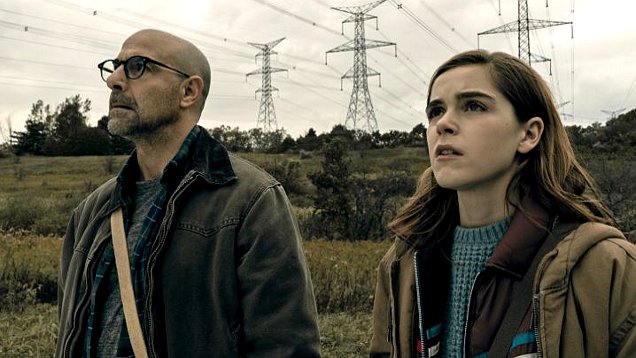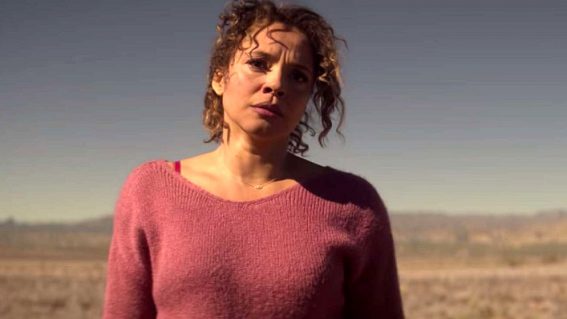Netflix’s horror movie The Silence is a dreadfully dull Stephen King knockoff

Feral flying things that hunt by sound attack Earth in Netflix’s new environmental horror movie. The writing is stodgy, the execution is pedestrian and the characters are boring sods, says Luke Buckmaster.
In Netflix’s dreadfully dull horror movie The Silence, Earth is attacked by beasts that hunt by sound, drawing inevitable comparisons to another recent film sharing a similar premise and a ‘keep it down’ title: John Krasinski’s A Quiet Place. The release of these movies in such close procession reminded me of a period in the 90s when everything from Hollywood seemed to arrive in pairs, from animations about insects (Antz, A Bug’s Life) to lava-spitting disaster movies (Dante’s Peak, Volcano) and imbecilic action films involving skydivers (Terminal Velocity, Drop Zone).
In the wake of the terminally unimaginative The Silence, a monotonous affair from director John R. Leonetti, Krasinski’s well-made genre pic looks like a masterpiece by comparison. Like many Netflix originals, including the recent Bird Box – another world-gone-to-the-dogs B movie with an environmental creature feature twist – the writing in The Silence is stodgy and the execution pedestrian, with a thick, gluggy, insufferable air of ennui smothering the life out of it.
The enemy creatures are small creepy flying things with long, Alien-like skulls: The Langoliers meets The Birds meets the flying monkeys from Wizard of Oz meets the tooth fairies from Hellboy. Why do ferocious alien critters always have bad teeth? Can’t some extraterrestrial species take pride in quality dentistry?
After attempting a pants-wetting dramatic prologue, which is one of those annoying clipped intro scenes that show screaming, hysteria, a bit of body fluid and little else, Leonetti and his screenwriters (Carey Van Dyke and Shane Van Dyke, adapting a novel by Tim Lebbon) switch their focus to deaf 16-year Ally Andrews (Kiernan Shipka). While leaving the schoolyard she reflects, in a slab of wishy-washy voiceover, on the experience of losing her hearing, unselfishly explaining that “I feel my parents lost the most.”
Yikes, this narration is bad. Worse, perhaps, is that it is also entirely inconsistent, disappearing from almost all subsequent scenes before inevitably returning at the eleventh hour. The storyline is simplistic, following Ally and her parents (Stanley Tucci and Miranda Otto) as they take to the woods to escape the flying feral fiends, grappling with dilemmas such as what to do about the family dog in the car that won’t stop barking. Sorry Rover, you might be out of luck.
One early scene is reminiscent of an unforgettable thread in the great feature-length final episode of TV’s M*A*S*H*, Goodbye, Farewell and Amen, in which a chicken on a bus makes too much noise in a war zone. In The Silence, Leonetti pauses to capture the final moments of a woman and her baby on a train, which is crying while panicked commuters try to remain silent. Because of her noisy bub, this doomed lady is instructed to leave the train (sadly, nobody drops the pun “no ticket!”) and then of course bad things happen.
That moment in and around the family car, with the feral flying things attacking, and then losing interest, and then attacking again, keeps going well after the point that the scene has stopped being remotely interesting. This painful pattern continues throughout the running time. Whereas Krasinski’s reluctance to move between set pieces felt like an artistic decision, labouring over each location to probe it for atmospheric detail, here the same reluctance feels like a cost-cutting measure. Reduce the locations and you reduce the budget.
Alfred Hitchcock’s The Birds is still a terrifying film today, many years after its special effects ceased being remotely impressive. Everything is about the state of dread – something so powerfully felt, and so challenging for filmmakers to capture. When they do it right you feel it in your bones. Lengthy occasions in The Silence in which very little happens indicates the work as an attempted mood piece; to say it falls short is something of an understatement. Leonetti’s film has the vibes of a dodgy Stephen King adaptation.
In the classic George Romero style, external horrors are exacerbated by interpersonal friction, fellow human beings posing some of the greatest threats to the Andrews family. But the scariest thing about The Silence is that so little happens for so long. One feels the desire to grab this film and shake it to life. Finally, eventually, after long stretches in storytelling wilderness, an ending – if you can call it that – arrives out of nowhere and that bloody voiceover returns.
The actors do what they can (it’s nice to see Australian Miranda Otto in a significant role) but they are at the mercy of much more powerful elements, reduced to shrieking at globs of CGI. The characters are also boring sods who were presumably rehearsing hammy monologues when the writing gods were handing out personalities. Do we want them to survive, or do we want them to be gobbled up by those mangy dentally-challenged critters? If the pooch doesn’t make it out alive, they don’t deserve to either.

















